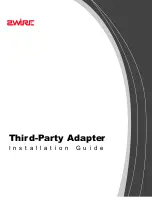
B.3 STT (SURFACE TENSION TRANSFER)
The Invertec STT power source is a high-frequency, current-controlled machine that delivers
power to the arc based on immediate arc requirements. The Invertec STT produces large
electrode current changes within microseconds. It operates in the short-circuiting welding mode.
The electrode current supplied by the power source is guided by the arc voltage state. An
ordered sequence of events controls the current throughout the droplet transfer process. The
electrode current and voltage waveforms for a typical welding cycle are shown in Figure B-3.
Following Figure B-3 are detailed descriptions of the STT welding cycle events.
FIGURE B-3. ELECTRODE CURRENT AND VOLTAGE WAVEFORMS
FOR A TYPICAL STT WELDING CYCLE.
B-4
Appendix B
STT WAVE SHAPING PRINCIPLES
WAVE DESIGNER
p
Surface Tension Transfer™
Electrode
Electrode to
work volts
Electrode
Amperes
T
T T
T
T
0
3 4 5
6
7
Time
27850063
T
T
T
1
2
T
0
– T
1
A
background current
between 50 and 100 Amps is delivered to the arc prior
to shorting of the electrode to the weld puddle. Background current is a steady-
state current level that serves two purposes. First, the background current
supplies power to the arc to maintain the fluidity of the molten drop at the end of
the electrode. (Failure to supply the minimum required current causes the upper
portion of the molten ball to freeze. As more of the ball solidifies, arc instability
and finally stubbing occurs.) Secondly, the background current level greatly
effects plate heating.
T
1
– T
2
Ball time
occurs when the electrode initially shorts at the background current
level. When the Invertec’s arc voltage detector circuit signals that the “arc” is
shorting out, the background current is immediately reduced for approximately
0.75 milliseconds. The rapid current drop promotes good electrical contact and
“wetting” of the ball to the weld puddle. Wetting prevents an “incipient short”,
wherein the ball is violently repelled from the weld puddle, breaking apart and
causing spatter.
Summary of Contents for WAVE DESIGNER
Page 2: ......
Page 6: ...iv iv LICENSE INFORMATION WAVE DESIGNER...
Page 26: ...3 14 Section 3 SOFTWARE OPERATION WAVE DESIGNER...
Page 30: ...4 4 Section 4 ARCSCOPE WAVE DESIGNER...
Page 32: ...5 2 Section 5 TROUBLESHOOTING WAVE DESIGNER...
Page 54: ...A 22 Appendix A PULSE WAVE SHAPING PRINCIPLES WAVE DESIGNER...
Page 74: ...INDEX Index 4 WAVEDESIGNER...
















































